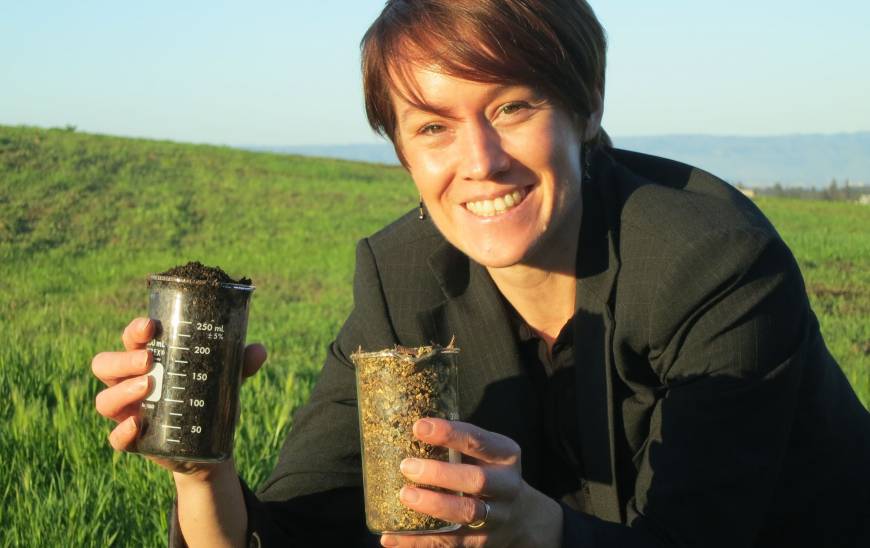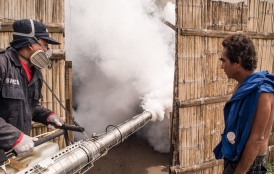The Stanford School of Earth, Energy & Environmental Sciences is now part of the Stanford Doerr School of Sustainability.
This page is currently being maintained for archival purposes only. For the latest information, please visit us here.
Understanding how mountains and rivers make life possible
Kate Maher and Page Chamberlain have modeled how the topography and rock composition of a landscape affects the process by which carbon dioxide is transferred to oceans and eventually buried in Earth’s interior.
By
Ker Than
March 14, 2014
Matthew Rothe

Stanford assistant professor Kate Maher holds up two different soil types. The soil on the left is young, dark, and composed of more chemically reactive minerals. The sample on the right is older and made up of less reactive minerals such as clays.
Favorable conditions for life on Earth are enabled in part by the natural shuttling of carbon dioxide from the planet’s atmosphere to its rocky interior and back again. Now Stanford scientists have devised a pair of math equations that better describe how topography, rock compositions and the movement of water through a landscape affects this vital recycling process.
Scientists have long suspected that the so-called geologic carbon cycle is responsible for Earth's clement and life-friendly conditions because it helps regulate atmospheric concentrations of CO2, a greenhouse gas that acts to trap the sun’s heat. This cycle is also thought to have played an important role in slowly thawing the planet during those rare times in the past when temperatures dipped so low that the globe was plunged into a "snowball-Earth" scenario and glaciers blanketed the equator.
"Our equations suggest that different landscapes have different potentials for regulating the transfer of carbon dioxide," said Kate Maher, assistant professor of Geological and Environmental Sciences who developed the equations along with her colleague, Environmental Earth System Science professor Page Chamberlain. The research, which was supported by the National Research Foundation, is described in the March 14 issue of the journal Science.
The geologic carbon cycle begins when volcanoes release carbon dioxide into the atmosphere. Some of the CO2 mixes with rainwater and falls back to Earth as carbonic acid. On land, the carbonic acid chemically erodes, or "weathers," silicate rocks exposed at the Earth’s surface to produce bicarbonate and release elements such as calcium and magnesium that eventually wash into the ocean. Over millions of years, these elements are transformed into rocks such as limestone. When plate tectonics push the carbonate-loaded seafloor down into the Earth's mantle, the carbon is released again as CO2, which is vented back into the atmosphere through volcanic eruptions, thereby completing the cycle.
The equations developed by Maher and Chamberlain address the weathering component of the geologic carbon cycle. The amount of weathering that occurs depends on several factors. One is the makeup of the soil: older soils that have already been weathered dissolve more slowly compared to soils made of fresh rock. "As you weather soil and sediment over time, they become less and less chemically reactive," Maher said. “Physical erosion, which is often associated with mountainous regions, replenishes the soil with reactive minerals.”
Another consideration is the length of time that water spends flowing through the soil, a variable that scientists call the “fluid travel time". The more time rainwater spends flowing through soils, the more weathering that occurs. The fluid travel time is in turn affected by the topography of the landscape–water tends to flow more slowly across a flat surface than down an incline.
In the real world, these different factors interact in complex ways. They might work together to speed up the weathering process, or they could oppose each other to slow the process down. For example, consider precipitation falling onto a mountain. Because of gravity, the corrosive water may flow more quickly through the mountain, thus reducing the fluid travel time. However, the soils in mountainous regions also tend to be younger and thus richer in elements such as calcium and magnesium, and as a result are more reactive and easily weathered. The competition between the flow of water and the reactivity of the soils limits how much weathering can occur. Maher and Chamberlain argue that these limits are important for maintaining CO2 levels within an acceptable range to maintain temperatures suitable for life.
The equations could improve scientists’ understanding of the geologic carbon cycle by integrating the study of the interactions between the geologic and hydrologic factors that affect rock weathering. Prior to this, scientists tended to study the influence of topography and water on chemical weathering separately. "Our work provides a quantitative framework that links together many qualitative observations from modern weathering environments, but also provides new hypotheses regarding how these processes may work together," Maher said.
Maher and Chamberlain are currently using real-world observations of rivers from around the world to modify and improve their equations.
Ker Than is associate director of communications for the School of Earth Sciences.







